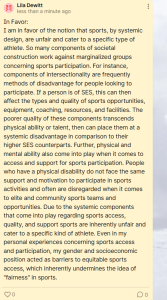2
Section One: The Fundamentals
A) History and Context
Exercise 1: Notebook Prompt
| To be completely honest, I was completely unaware of the DSD policies within Olympic sports and the particular levels of acceptable testosterone in female athletes. It was surprising to hear that women, regardless of talent and ability, can be completely disregarded and excluded from sport as whole. Testing for DSD and the processes of undressing and gaining samples are incredibly invasive and personal, and yet is mandatory in order for athletes to compete on a “fair” playing field. Especially for Maximilia, she had no idea why those tests were conducted. By keeping her in the dark for months, not only did she not gain reasonings behind the invasive examination she underwent, but also had to have the results shared with her in a heartbreaking and painful way. By being told about her DSD, she was informed that she would be unable to participate in the Olympics, which must have been shocking to hear and come to terms with.
I learned that these women with DSD had to undergo surgery or take drugs in order to alter her testosterone levels. The expectation for athletes to completely alter their bodies in order to fall under the “rules” within the Olympics and sports events guidelines is unfair and inherently discriminatory. While testosterone levels do have merit, using it as means to exclude certain athletes is unfair and disregards their talent for strict biological differences. The normalized and accepted cultural norms for what male and female traits should look like are systemically ingrained in misogyny and sexism, and by abiding by these guidelines it perpetuates that sexism and misogyny. It was also very interesting to learn that cards verifying an athletes femininity seems like an incredibly archaic practice. The idea of being verified as a woman in order to participate in sports and having to be issued a card that states so emits the feeling of policing women’s bodies in another form. The policing of women’s bodies occurs in many different sanctions of society, and within the sports realm, this card issuing process acts as a method of control and verification of an identity women already acknowledged having.
|
B) Timeline of History
Exercise 2: Notebook Prompt
What other significant case/milestone would you add to this timeline? Note it in your notebook along with a brief (one or two sentences) explanation of why you feel it is important.
| In July of 1950 the first sex verification test was conducted for women one month before the European Championships in Belgium. I think this is significant because this marks the very beginning of actual conducted tests on women’s bodies in sports. This date not only demonstrates how women’s bodies have been policed and judged for over half a century, it also marks the beginning of discrimination against women with DSD and sexual differences in sport and athletics.
|
C) Gender coding in Sports
Exercise 3: Notebook Prompt
Has the gendering of sport ever been a constraint on your involvement? How?
Or, if not, why do you think this is?
| In my experience, the gendering of sport has been a constraint on my involvement especially throughout high school and elementary school. In elementary school, that was the height of my sports interest, and I would want to participate with the boys at recess in what ever sport they were playing at that particular time. For instance, the boys would frequently choose to play football. In the processes of choosing teams, the girls, including myself, would always be the last ones to be picked, regardless of our previously displayed sports ability. Continuously being the last choice in team selection made me question my capabilities and made me insecure when playing. Further, during the actual game, me and the other girls would rarely get passed to. I could have been in the most optimal placement for a touchdown or even increasing our placement down the field, and yet they would find anther boy to pass to instead. This exclusion within my inclusion of the game caused me to not only become more insecure in my abilities because I was never given the opportunity to better myself, it also caused for me to become bored within the game. By acting as a player that was never engaged with, I not only was not able to participate, I had to watch as my team would frequently lose the ball to the other team because they would pass to anyone else besides a girl. The inherent bias the boys displayed against girls in sports resonated with me in a negative way, and instilled a sense of insufficient within my sports participation. Later on in high school, I at this point had lost my interest and admiration for sports and sports participation. In addition to my lack of motivation, the sports teams available to girls at my school were limited to rugby, volleyball and basketball. While there were options for girls, there were many more options for boys to choose from and participate in. This disproportionate attention, funding and availability for male sporting events at my high school reinforced my previous ideas of male and female sports, and female ability in sport. While I am aware that many women are extremely talented in their sport of choice and show incredible ability, many girls do not have the same foundational grounds to build these competencies that boys do. Starting from elementary school, through high school and even into professional sport and advanced teams, girls sports face decreased funding, lower quality equipment and are overall ata systemic disadvantage due to ingrained sexism within sport.
|
D) How is sport gendered in the popular imagination?
Exercise 4: Padlet/Notebook Prompt
While most sports are in fact unisex, gender coding remains pervasive, particularly at the professional level, although with a foundation established in youth competition. Participate in the poll below to share your views on how popular sports are gendered in the popular imagination. Also feel welcome to add or suggest sports that you feel strongly conform to the gender binary!
After you contribute to the padlet prompt, record your response in your notebook AND briefly discuss in two or three sentences how these responses and the polling figures in general confirm or contradict your assumptions about gender-coding and sports. Did anything surprise you?

Overall in these poll responses, I was aligned with the general consensus of what gender comes to mind in the popular imagination. Something that surprised me was the fact that for tennis there was a 0% for people considering it a male sport. While female tennis is more popular in sports media, it was interesting to see that men are not considered the sole participants in the sport, showing women’s influence in the field.
|
Section Two: Breaking it down
A) Title IX
Exercise 5: Notebook Prompt
In a longer version of the interview excerpted in the video above, Leah Thomas states “Trans women competing in women’s sports does not threaten women’s sports as a whole because trans women are a very small minority of all athletes and the NCAA rules around trans women competing in women’s sports have been around for 10+ years and we haven’t seen any massive wave of trans women dominating”?
Do you agree with this statement? See also the image above suggesting that the issue may be overblown by politicians and influencers who don’t actually care that much about women’s sports.
Please share any thoughts you have in your Notebook by clicking on the audio button above or writing a few sentences.
| At the end of the day, I believe that trans women and trans men should be able to participate in the sport that correlates to their gender identity. However, I do feel that this is a multifaceted issue of biology, basic muscle structure and opportunity. I do not believe that trans women are a threat to women’s sports, and it is extremely convenient that people only care about women’s sports when a trans person is involved. The concern for trans women is sports on a grand scale feels like a moral panic and an overblown issue masking the accomplishments in women’s sports. However, I also have to consider the biological differences between men and women, and how male and female puberty result in differing muscle structure and hormonal balances. I have been thinking about this issue for years, and I am still unable to come to a concrete opinion in regards to how to approach this issue. I am a part of the LGBTQ community myself and want people in my community to have equal opportunity and equity, however there is issue with biology as a fundamental component. One thing I do not agree with as a whole is Riley Gains disregarding and disrespecting trans people and their preferred pronouns in retaliation to trans women in sports. Being the face of not including trans women in sports, reproducing this harmful rhetoric has harmful implications onto the trans community and reinforces the idea that they are not the gender they conform to. This harmful ideology causes for violence and harm to come to trans women, when they already face disproportionate violence in society.
|
B) Unfair Advantage?
Exercise 6: Notebook Prompt
What does the host and writer, Rose Eveleth, have to say on the issue of unfair advantage?
Can you think of other examples of unique biological or circumstantial advantages from which athletes have benefitted enormously that have nothing to do with gender?
| The testing and policing of women’s bodies to alleviate the issues of an “unfair advantage” has resulted in result for female athletes facing discrimination and scrutiny at the hands of a genetic difference they did not have control over. The questioning of fairness in regards to DSD, women’s bodies, the definition of femininity, and the category of female disproportionately affects women’s bodies in sports and results in the over-policing and governing of women in professional sports. These components of governing women’s bodies and forcing them to take either testosterone-blocking or testosterone-lowering medications have thus caused questions about the ethical implications of these regulations, and how athletes’ personal and professional lives and careers are impacted due to these regulations and governance. The ultimate choice these women have to face as a consequence of their genetic differences boils down to either giving up their dreams of participating in the Olympics and representing their country on a global scale, trying to contest the rules placed against them, or medicating their bodies and alter their hormonal levels to fall within the deemed “acceptable” range of testosterone for female athletes.
Other components of unique biological advantages that benefit athletes outside of gender can stem from physical traits and cognitive differences. For instance, Tom Brady faces circumstantial benefits that are separate from his gender and more so rely in his socioeconomic status, access to certain facilities and his status as an elite football player. He has been able to use these components to his advantage through being able to have the best forms of nutrition and diet, personalized and professional training and efforts placed into scientific developments that have allowed him to prolong his football career, continuously push back his retirement and continue to play past the normal age of retirement
|
Again, let’s turn to Katie Barnes who points out that we tend to forget amidst all the debate that “sports, by design, are not fair” (235), that “the reality of sports is that we accept unfairness all the time” (235).
Do you agree? Why? In your experience, how fair are sports? Feel welcome to add a video response in the padlet and provide an example if you’re willing. Make sure you include a screenshot of your response in your notebook.

My response:
|
B) The Paris Olympics
Optional Response:
What does Robins mean when she argues that:
“The aims of transvestigating an Olympic athlete are not, in any meaningful sense, anything to do with sports, or fairness, or even with women (cis women, at least) as a social category. Rather, they have everything to do with transness, and the public expression of transfemininity.
For my money this has never been about sport.
What it has always been is an excuse to publicly relitigate the existence of trans women.”
Make a note in your Notebook.
| Transvestigating in this instance refers to investigating an athlete’s gender identity, especially for female athletes, and placing it under the guise of maintaining fairness and equitability in sport. These investigations on what gender identity is, should look like, and should be expressed is in fact not about maintaining fairness in sport, and instead are focused on reinforcing the gendered norm of female bodies and especially transwomen and trans femininity. By transvestigating women and trans women in sports reinforces the harmful concepts of what femininity should look like and how it should expressed. Further, it is not about protecting the fairness of sports and more so focuses on delegitimizing the existence and gender expression of trans women. The space of Olympic and professional sports is not about maintaining fairness, and instead becomes a space for debate and scrutiny for women, transwomen, and depictions of gender identity for women in sport. Social and political politics are continuously entangled with the idea of gender identity and use sport as a setting for debate and discourse. Overall, the idea of transvestigating and policing women and trans women in sport centralizes around the idea of what femininity looks like, should look like and guises it under the concept of fairness and equitability in sport.
|


